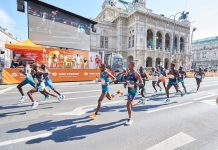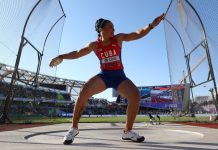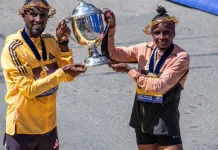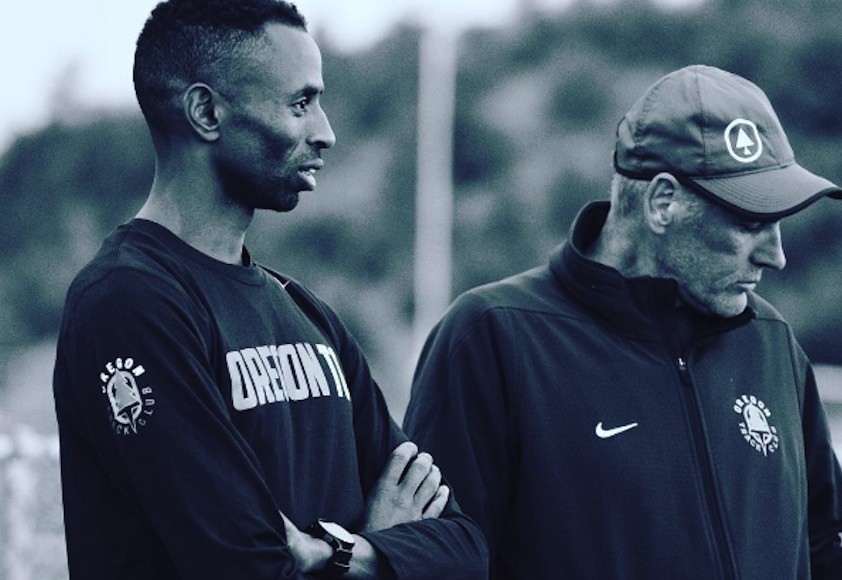Locker Room Talk with the Head Coach of the Oregon Track Club, Mark Rowland
Mark Rowland is the British Record Holder in the 3000m Steeplechase (8:07.96) which he ran at the Seoul Olympic Games in 1988 en route to the Bronze Medal. Since 2008 he has been based in Eugene as the Head Coach of the Oregon Track Club.
 A lot of coaches begin a new block with lactate testing, time-trials etc. to get a measure for where their athletes are at. Is there anything specific along these lines you do at the start of a new season?
A lot of coaches begin a new block with lactate testing, time-trials etc. to get a measure for where their athletes are at. Is there anything specific along these lines you do at the start of a new season?
Generally, we start with an introductory period of 3-6weeks depending on the current conditioning of each individual then look at a full blood profile to confirm a baseline. If a new athlete is on board we’ll operate all the Lab tests [LT, Vo2Max etc] and then operate a field test threshold workout to determine their workout heart rates.
Priorities are to set good habits and routine so we’ll have the science support staff [Orreco] come into town and initiate/update protocols and operation plans. This year we are now in a position to make use of the new Redox technology [bio-marker analysis] at regular intervals. Training alone is not sufficient to gain a competitive edge, and the services should enable us to limit the number of training days lost from overtraining, illness and infection.
After the athletes 1:1 review [with myself] to determine what worked well, lessons we learned and mistakes made we’ll come up with a plan on short, medium and long-term goal setting. i.e. what aspects of preparation must be improved [technical, strength, recovery, fitness, coaching, medical etc] then most importantly agree on the plan of action.
 You have had many of your runners training at altitude at different times of the year. How do you alter training when accounting for elevation?
You have had many of your runners training at altitude at different times of the year. How do you alter training when accounting for elevation?
After the adaptation period we’ll operate the main workouts [ideally running the harder workouts at a lower elevation] but pay special attention to increasing recoveries and attempt to control intensities of recovery runs alongside increases in fuel and rehydration immediately after and during runs/workouts. Heart rate monitors are recommended to assist controlling recovery runs and greater quantities of SOS are taken on board!
You’ve just had Sally Kipyego run an incredible marathon in NYC. The likes of yourself and Jerry Schumacher, in particular, are showing that you don’t need to have run a marathon yourself to coach an athlete to a great one. What are a couple of key workouts you consider to be crucial for marathon preparation?
From my perspective, I coach athletes first and then the event second. I do not believe in being a ‘jack of all trades’ but I have known Sally for a considerable amount of time and understand how she operates. Sally was keen for me to continue to support and advise so we took some basic principles from people we have confidence in and made our own adjustments. As an athlete that has generally not operated on massive mileage the number one priority was to prepare her body to be efficient at Marathon race pace/effort and systematically increase the long run.
The decision for this stage of her career was to stabilize on alternating weeks of 19 and 25 miles as the long run and then learning to take on board fluids/fuel during the long runs. We also wanted to maintain and keep in touch with the 10-12k workout but emphasis was on Marathon and 1/2 Marathon pace. One key workout we did 4weeks out was a 20mile run that included alternating 3miles @ Marathon and 1/2M efforts.
Follow the progress of Oregon TC Elite and Mark Rowland as they head into 2017 @oregontcelite & @coachrow1
By Daniel Wallis - Runner's Tribe































